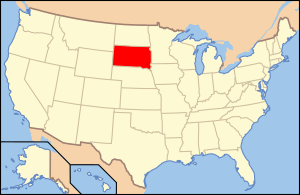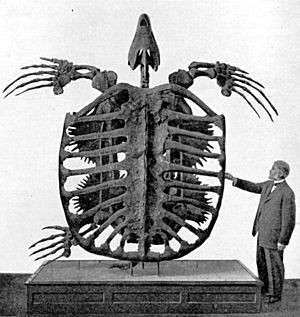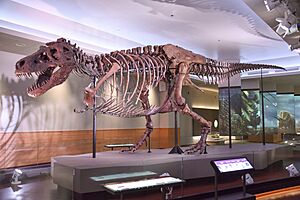Paleontology in South Dakota facts for kids

Paleontology in South Dakota is all about studying ancient life in the U.S. state of South Dakota. This state is a fantastic place to find fossils! Many fossils have been discovered all over South Dakota.
Millions of years ago, during the early Paleozoic Era, South Dakota was covered by a shallow sea. This sea was home to creatures like brachiopods (shellfish), cephalopods (like squids), corals, and ancient fish called ostracoderms. The sea levels changed a lot during the Carboniferous Period. By the Permian Period, the sea had completely left the state.
During the Triassic Period, South Dakota became a wet coastal plain. But by the Jurassic Period, it was under a sea again where ammonites (shelled creatures related to octopuses) lived. In the Cretaceous Period, South Dakota was also covered by a sea. This sea was home to huge marine reptiles called mosasaurs.
The sea stayed even after the start of the Cenozoic Era. Eventually, it dried up, and land animals took over. These included early camels called Poebrotherium, three-toed horses, rhinoceroses, saber-toothed cats, and giant plant-eaters called titanotheres. During the Ice Age, huge glaciers moved into the state. At this time, mammoths and mastodons roamed South Dakota.
Long ago, local Native Americans believed fossils were the remains of a water monster called Unktehi. They even used pieces of Baculites shells (a type of ammonite) in magic to help find buffalo herds. Scientists first learned about South Dakota's fossils from the Lewis and Clark Expedition. Today, the Cretaceous horned dinosaur Triceratops horridus is the official state fossil of South Dakota.
Contents
Ancient Times in South Dakota
Paleozoic Era: Life in the Ancient Seas
South Dakota's fossil story begins in the Paleozoic Era. No fossils have been found from the very oldest time, the Precambrian Period. At the start of the Paleozoic, a sea covered South Dakota. During the Cambrian Period, the life in this sea left behind many trace fossils, like tracks and burrows.
Other sea creatures from the Paleozoic included brachiopods, cephalopods, and corals. The sea briefly left South Dakota during the Ordovician Period. But in the middle or late Ordovician, ancient fish called ostracoderms swam over the area. Similar fish fossils have been found in Colorado.
Later, during the Carboniferous Period, sea levels went up and down again. Marine life from this time included brachiopods and corals. But rocks also show there were areas with salty or fresh water. The sea completely left South Dakota during the Permian Period. At this time, old sediments were worn away instead of new ones being laid down.
Mesozoic Era: Dinosaurs and Sea Monsters
Sediment began to build up again during the Triassic Period. The rocks tell us that South Dakota was a wet coastal plain back then. Seawater covered South Dakota once more during the Jurassic Period. This sea was home to creatures like ammonites, clams, crinoids (sea lilies), and starfish.
As the sea pulled back, South Dakota became a land environment. It had lakes, streams, and swamps. The state was covered by the sea again during the Cretaceous Period. This sea, called the Western Interior Seaway, was full of many invertebrates (animals without backbones), aquatic birds, and marine reptiles. The Cretaceous life in South Dakota was similar to what is found in Wisconsin.
Some of South Dakota's ammonites were very unusual. During the Late Cretaceous Period, the Black Hills area of South Dakota might have attracted long-necked plesiosaurs. These sea reptiles may have traveled hundreds of miles to find gastroliths (stomach stones) there. Short-necked plesiosaurs like Dolichorhynchops also lived in South Dakota's Western Interior Seaway. They were fast swimmers that ate small fish and cephalopods. Most short-necked plesiosaurs were small, less than ten feet long. However, one South Dakota fossil was about 20 to 23 feet long!
More shark species have been found in South Dakota's Cretaceous Western Interior Seaway deposits than in other states. This includes places like Kansas, which had similar shark communities.
During the Late Campanian Age, South Dakota was home to the giant sea turtle Archelon ischyros. The first fossil found was about 11.5 feet long. Archelon is the largest known turtle ever. It was about the size of a small car! Also during the Cretaceous, the Black Hills in western South Dakota were forming due to geologic uplift. Local dinosaurs included the armored Edmontonia, the duck-billed Edmontosaurus, the ostrich dinosaur Ornithomimus, Pachycephalosaurus, Triceratops, and Tyrannosaurus.
Cenozoic Era: The Rise of Mammals
In the early part of the Cenozoic Era, central and eastern South Dakota were still covered by the sea. The Black Hills continued to grow taller. As the Cenozoic went on, the sea slowly left the state. In its place, huge grasslands grew. Herds of grazing mammals roamed these grasslands.
Later, during the Oligocene Epoch, at least part of South Dakota was still covered by seawater. The White River Formation was being laid down in the White River badlands as the sea slowly pulled back. Few plant fossils from the Oligocene have been found. These include hackberry seeds and petrified wood. Even though plant fossils are rare, these deposits have some of the best mammal fossils in the world from the Tertiary Period. More than 175 different kinds of animals from this time have been preserved.
The mammals found here included three-toed horses, pig-like animals, the camel Poebrotherium, Protoceras, rhinoceroses, rodents, saber-toothed cats, tapirs, and titanothere giants. Ancient birds also left behind bones and even an egg. These are very important because bird fossils are usually very rare.
Many streams carried even more sediment into the region from the young Rocky Mountains and Black Hills. At that time, South Dakota had plains with marshes and shallow lakes. Wide streams cut through the land. Some of the Oligocene wildlife left behind footprints that later turned into fossils. The Brule Formation has one of only seven Oligocene fossil track sites in the western United States. Sometimes, volcanic activity would cover the state with ash.
During the Ice Age, huge glaciers moved across the state. As they melted, they left behind sediments. These sediments preserved the fossils of creatures like bison, horses, mammoths, and mastodons.
Discovering South Dakota's Past
Early Scientific Discoveries
On September 10, 1804, four members of the Lewis and Clark Expedition wrote in their journals about finding fossils. They found them along the Missouri River in what is now Gregory County. They found a 45-foot-long backbone, ribs, and teeth at the top of a high ridge. The men thought these were from a giant fish. Today, scientists believe it was probably a mosasaur or plesiosaur. The expedition sent some fossils back, but they were later lost.
In 1847, Hiram A. Prout wrote about a piece of a titanothere jaw found in the White River Badlands. Soon after, Joseph Leidy described the Oligocene camel Poebrotherium, found in the same area. The government then sent an expedition to the area. In 1850, the Smithsonian sent its own collectors. The search for fossils in the White River Badlands went on for decades. In 1920, the South Dakota School of Mines published a report summarizing all the fossil work done there. In 1877, the United States Geological Survey published a report on South Dakota's ancient plants and invertebrates.
In 1895, George Wieland found YPM 3000. This was a nearly complete fossil of the giant sea turtle now known as Archelon ischyros. It was preserved in the Pierre Shale. This discovery likely led to Wieland's research on Late Cretaceous sea turtles the next year.
In 1940, the South Dakota School of Mines and Technology worked with National Geographic on an expedition to the badlands. They found tons of fossils from at least 175 different species of Oligocene life. The fossils were taken to the South Dakota School of Mines in Rapid City. Among the mammal finds were rhinoceroses, tapirs, three-toed horses, pig-like animals, and rodents. The team also found some very rare bird fossils, including a fossil egg. Only a few plant fossils were found, like hackberry seeds and petrified wood. Some fossils were in dangerous spots, so excavators had to use ropes and pulleys to lower them from tall rock formations. These fossils were found in river sandstones that had not been studied much before.
In June 1947, the South Dakota School of Mines sent another expedition to the Badlands. They found many different fossils from the Oligocene White River Formation. These included rhinoceroses, saber-toothed cats, giant pig-like animals, Protoceros, tapirs, and horses.
In 1990, Sue Hendrickson found a new Tyrannosaurus rex fossil. It was later nicknamed "Sue" after her. This fossil made headlines because of a long fight over who owned it. After more than five years, it was decided that the fossil belonged to the owner of the land where it was found. The rancher sold the fossil at auction, and the Chicago Field Museum bought it for $8.36 million.
In 1996, Bell and others reported finding a mosasaur of the genus Plioplatecarpus in South Dakota's Pierre Shale. This fossil was important because it had several baby skeletons inside its hip area. Similar fossils have been seen as proof that some marine reptiles gave live birth.
Places to Explore Fossils
- Badlands National Park
- Fossil Cycad National Monument (this park no longer exists)
Paleontology Museums
- Grand River Museum, Lemmon
- The Journey Museum, Rapid City
- Lemmon Petrified Wood Park & Museum, Lemmon
- The Mammoth Site Museum of Hot Springs, Hot Springs
- Museum of Geology, South Dakota School of Mines & Technology, Rapid City





